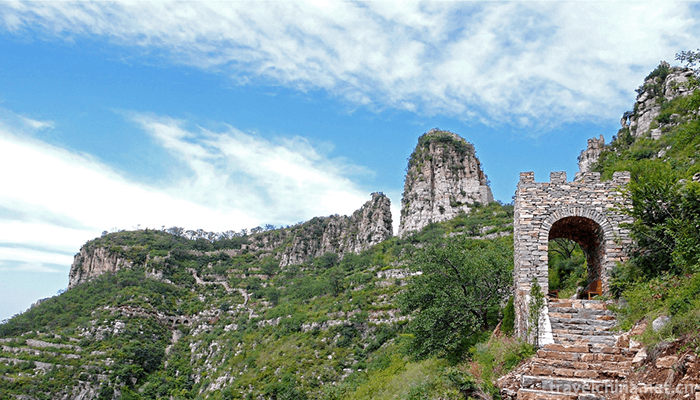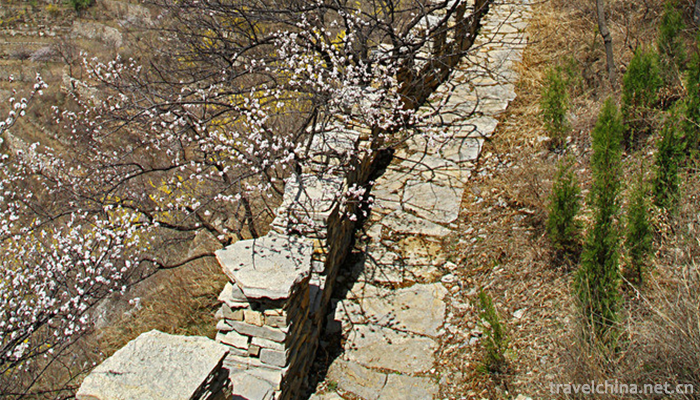Yongquan Qicheng Great Wall Ecological Scenic Area
The Great Wall of Yongquan Qi is a quiet tourist scenic spot, located in Yongquan Village, Zihe Town, Zibo City, where Pu Songling lived in the southeast mountain area. Here the mountains are connected, ancient trees embrace each other, green waves roll in the breeze, birds singing and flowers fragrance, green leaves in the daytime shake the sunshine and sprinkle gold, and in the quiet night full of bright, silver glitter. Layers of terraces, white clouds, ancient trees will dress up the mountain villages in a variety of styles; fresh air, green surge gives you endless joy and pleasure.
Survey of scenic spots
Yongquan Qicheng Great Wall Eco-Scenic Area is located in Yongquan Village, Zihe Town, Zichuan District, Zibo City, Shandong Province. It covers an area of more than 300,000 mu, with an elevation of more than 500 meters and surrounded by mountains on three sides. It has a history of more than 3,000 years. There are dozens of national historic sites such as Meng Jiangnu Landscape Avenue, Qi Great Wall Site Protection Park, Meng Jiangnu Memorial Hall, Meng Jiangnu Cultural Park, Damo Hall, Sun Bi Xie Ma Tang Buddhist Cultural Area, and many other natural landscape groups such as Shengquan Dragon Temple Landscape Group, Centennial Ancient Trees Group, Buddhist Sitting Sacred Mountain and the largest in Luzhong. At the same time, the scenic spot also has Yongquan Villa Leisure Resort, Shimofang Qicheng Great Wall original ecological food production base, so that you can fully enjoy the original ecological gifts brought by nature.
Meng Jiangnu Landscape
Meng Jiangnu Landscape Avenue. It is Yongquan Qicheng Great Wall Company that, in commemoration of Meng Jiangnu's legend, has been approved as a national intangible cultural heritage and is convenient for tourists to visit. It has built a sightseeing route around the main scenic spots along Meng Jiangnu's path, which is named Meng Jiangnu's sightseeing avenue. The road is 3 kilometers long. The starting point is Laojing, through the Children's Paradise, Meng Jiangnu's former residence, Longwang Temple, Qibing Development Base, Wangjialing, Damotang, Sun Po Xietang, Yongquan Buddha, Guanyin, Pear Tree Garden, Kailin, Meng Jiangnu Cultural Park and other sightseeing spots. Along the way, terraces layers, ancient trees into forests, picturesque scenery.
Qi Great Wall Site
Qi Great Wall Site Preservation Park, located at the top of Yongquan splitting mountain, is the most complete ancient Qi Great Wall site preserved in China. There are ancient Qi Great Wall site, splitting mountain pass, beacon fire tower, a line of days, Meng Jiangnu cried down the broken wall of the Great Wall, Jiangnutai, Lianxinqiao and other historical sites in the park, which are the best portraits and miniatures of Qi Great Wall. At the same time, Meng Jiangnu cried at the foundation of the story of the Great Wall which has been passed down for 2000 years.
Meng Jiangnu's former residence
The Memorial Hall of Meng Jiangnu's former residence is located in the southeast direction of the scenic spot. It is said that the Qi people Jiangnu came to the foot of the Qi Great Wall to search for her husband. She was hungry and cold, sleeping at the foot of the Qi Great Wall. She was rescued by a Meng surname couple and recovered after half a year. In order to thank for her rebirth, Jiangnu crowned her with Meng surname and recognized her as a righteous father and a righteous mother. The Meng House where Jiang Nv lived was later called Meng Jiang House. Now it is restored to Meng Jiangnu's former residence, and on this basis, a memorial hall of Meng Jiangnu's former residence has been built.
Meng Jiangnu Cultural Park
Meng Jiangnu Cultural Park, located in the split mountain ridge, is a memorial cultural park built to commemorate the goddess of love Meng Jiangnu. It is also a link between the past and the future of Tianmen in the protection garden of the Qi Great Wall site in Yongquan Scenic Area. It is the starting point to reach the ancient Qi Great Wall and the South Tianmen. There are sculpture groups, Memorial pavilions, Wangfushi, Shihu, Mengjiangnu Stone House, hand-held trees, rock paintings, Zhongtianmen, ancient mountain climbing gates, sentry pavilions, Jiangnu Temple, couple trees, and the footprints left by Avalokitesvara and other attractions in the park.
Damotang Ecological Zone
The ecological scenic spots of Damo Hall include Damo Ting, Damo Ridge and Damo Hall. Legend has it that in order to help Sun Bin, Damo Xiansheng this place, according to the instructions of his ancestors, the generals excavated the spring water to commemorate the personal names of Damo's benevolent grandson Bin. A beautiful and magical legend has become a landscape. Ancient trees, huge stones for thousands of years, people walk from here, as if through time and space, roaming in a deified world.
Sun Bin Xietang
Sun Bin's Xiematang Buddhist cultural area, including Xiematang, Yongquan Buddha, Mercy Guanyin, Pear Garden and other scenic spots, is said to be led by Sun Bin in battle, Meng Jiangnu's search for a husband is guided by Buddha and Guanyin. After the Battle of Maliantai, Sun Bin chose the picturesque spring to split the Shandong Valley for a military holiday, and named it Xiematang. At that time, the villagers lived and worked in peace and contentment. In order to thank God and Buddha for their blessings, the people began to untie their pockets to shape Buddha and Guanyin to express their gratitude. Sun Bingwen was very happy when he heard about it. He instructed the Master to investigate and confirm that Buddha was built in the southeast mountain of Xiamatang, Guanyin was built in the valley, and green bamboo was planted to protect him. Later, the general led officers and soldiers and villagers craftsmen to build Yongquan Buddha and the image of Mercy Guanyin in Dagan Yue. It was said that the Holy Spirit of the Buddha and the incense were flourishing. After several vicissitudes, the original Buddha statue was destroyed in the war. In 2008, the Qicheng Great Wall Company obeyed the public opinion and invited experts from Beijing to rebuild the statue at its original site.
Longwang Temple in Shengquan
The landscape group of Longwang Temple in Shengquan includes Shengquan, Longwang Temple, Shanhuayu, Wangjialing and other scenic spots. Legend has it that in 341 AD, Sun Bin led the army to rest here. One day the general was taking a nap under a regular tree. In his dream, he saw Master Damo drifting by a golden statue. He said to the southwest of his finger that there was a divine spring here. After Sun Bin awoke, he urgently excavated less than 1 metre, springs gushed out, and the officers and soldiers were clean and healthy after drinking. Sun Bin ordered the mountain spring to be the fountain. For many years, no matter how the weather changes, the spring is clear and sweet, and the villagers and pedestrians are refreshed after drinking, so it is known as the Holy spring. Because of the good weather of the ancient spring, in order to thank God, Yongquan and the villagers nearby raised funds to build the Dragon King Temple in the late Ming Dynasty. Every day when it is dry and rainless, villagers gather here spontaneously to pray for rain from the Dragon King. Legend has it that every request must be answered. This temple has been rebuilt several times, and the present temple was built on the original site by Qicheng Great Wall Company in December 2008.
Centennial Ancient Tree Groups
Centuries old trees. There are not only many trees in Yongquan, but also ancient ones. And there are a lot of rare trees! According to textual research, Yongquan Village was built in Ming Dynasty and moved from Linzinan Mill to a single surname. In the early Qing Dynasty, the Meng family moved from its neighbouring villages. Villages used to be wooded areas. With the increase of migrant villagers, some common woody tree species gradually disappeared due to the reasons of opening up wasteland, planting grain and grazing. But economic trees have been well preserved and increasing. Tens of thousands of pear trees, apricot trees, crabapple trees, persimmon trees, hawthorn trees, carriage trees and regular script trees with hundreds of years of age are scattered out of villages, on slopes, on valleys, by roadsides and by weirs, and they blossom and bear fruit year after year. Some trees seem to be old-fashioned, but they still sprout every year, blossom green and bear fruits. These economic trees have become an important part of the village, dedicating sweet fruits to people every year. Because of the existence of these ancient fruit trees, they constitute the most beautiful scenery of the mountain village.
Qibing Expansion
Yongquan Shuanglong Valley Qi Barracks Survival and Development Base is located in the Great Wall Scenic Area of Yongquan Qi, Shandong Province, east of the Lushan Mountains, surrounded by mountains, cliffs, peaks, rich vegetation. At an altitude of 800 meters, 200,000 mu of green land is the largest survival and expansion training base in Shandong Province. Professional development site and field development facilities are complete and perfect. Here are the eagle cliffs of "the first cliff" in Luzhong, as well as the highly challenging high-altitude sliding ropes, ladders, broken bridges, climbing ladders, fishing in muddy water, catching chickens by bare hands, camping, picnic, barbecue, featured roasting whole sheep and other park-featured experience projects, which can experience both the excitement of fashion and the leisure of farm fun.
Yongquan Villa
Yongquan Villa Leisure Resort, located in the Great Wall Scenic Area of Yongquan Qi, is divided into two districts, South and north. It is a large-scale leisure resort integrating catering, accommodation and entertainment. Yongquan Village is 500 meters below sea level and nearly 800 meters above sea level. Studies by international experts show that hilly slopes and hills at 500 meters above sea level are the most livable areas for human beings. Apart from having a "leisure" to live in, there is also a "quiet" and more "maintenance". There is an independent courtyard with beautiful surroundings and fresh air. It is like being in a natural oxygen bar. The natural scenery is beautiful and pleasant. For modern people with high tension of working rhythm, it can not only relieve fatigue, relax their body and mind, but also cultivate their temperament and purify their soul. Here guests can either close the courtyard door to choose their own dishes to cook, or make a telephone reservation to deliver meals to their doors. In the villa, 24 hours supply of high-quality mineral water, hot water bath, visitors to the village like home. Beautiful countryside scenery, fresh vegetables and game, fruit snacks, bridges and running water in the four seasons make people used to the hustle and bustle of the city truly feel the beauty of nature. Children's playground not far away is a good place for children to yearn for...
Tourist routes
Take No. 24 bus from Zichuan Bus Station to Happiness Station and get off to Yongquan Scenic Area.
Self-driving route
1. Zichuan-Hongshan-Xihe-Yuanquan-Zihe-Happiness-Yongquan;
2. From Boshan to Yuanquan Town-Zihe-Happiness-Yongquan;
3. From Linzi through Hutian-Hongshan-Xihe-Yuanquan-Zihe-Happiness-Yongquan.


0 Questions
Ask a Question
Your email address will not be published.